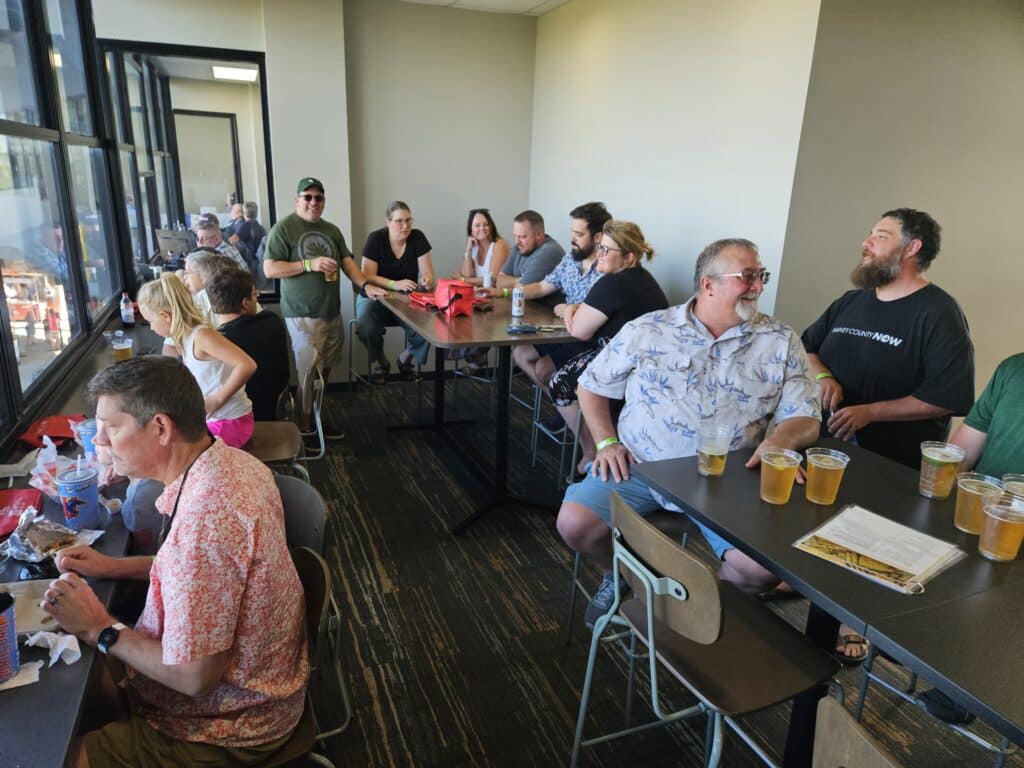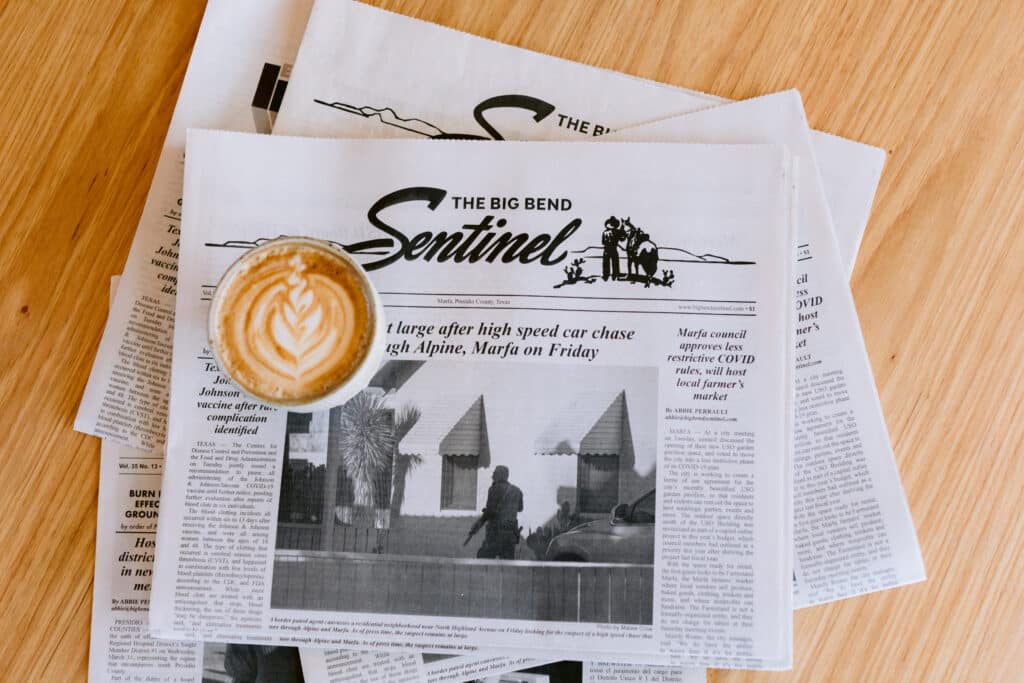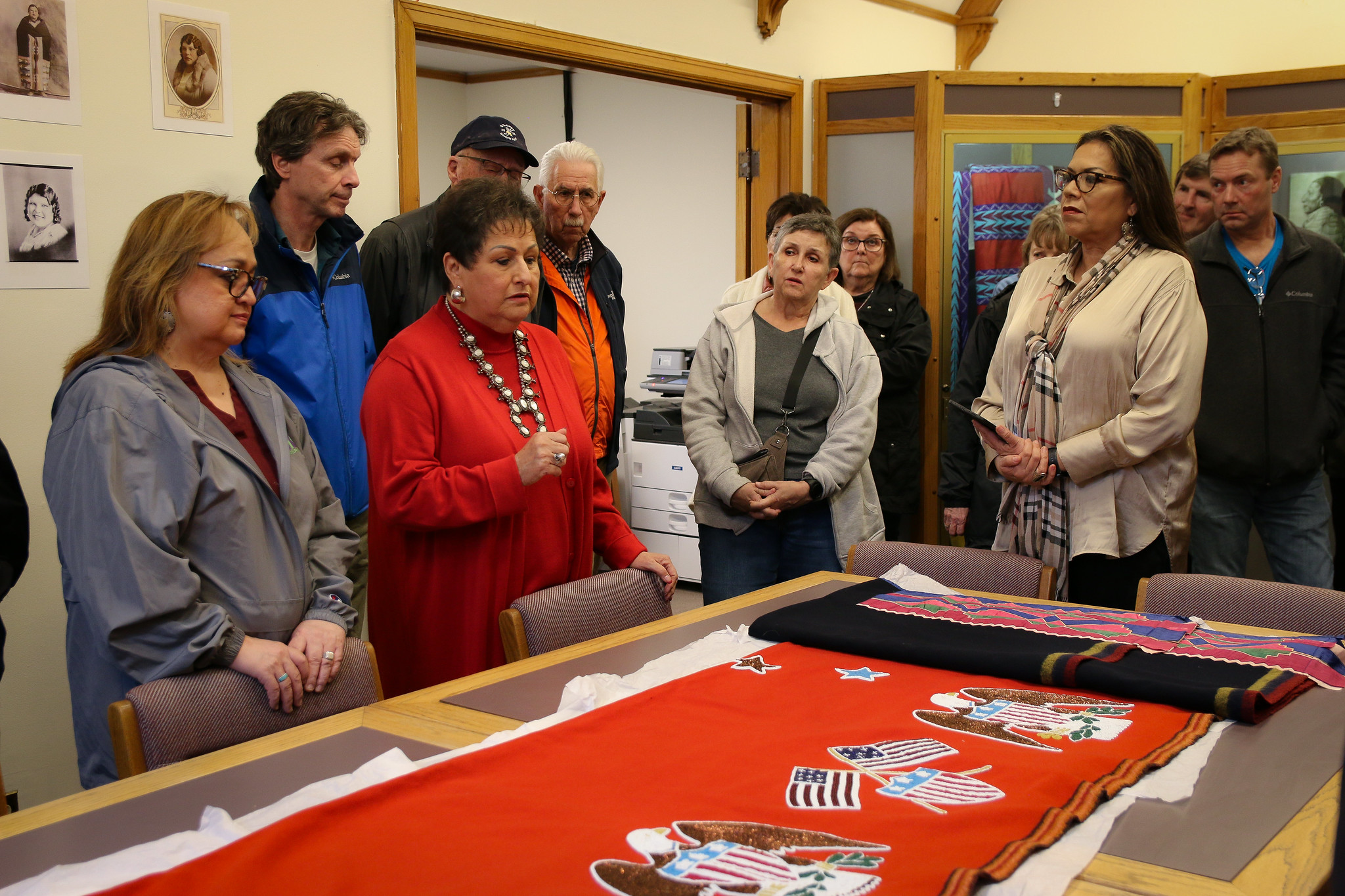
Billie Ponca, Grayhorse elder and former director of White Hair Memorial, speaks about Lillie Morrell Burkhart on the KOSU/Osage News Killers of the Flower Moon bus tour.
The Osage News is not just a news organization — we’re a community partner.
As our industry has shifted away from an advertising business model over the past 15 years, topics such as community engagement, community impact, news collaborations and financial sustainability have been heavily discussed. However, like many of you, I felt our small newsroom of four could not accomplish these initiatives and provide quality news simultaneously. I was convinced we didn’t have the staff or the time.
So in July 2023, when we were approached by a local NPR affiliate based at Oklahoma State University who wanted to host events with us about a buzzy Oscar-nominated film and the book it was based on, I accepted the invitation with trepidation.
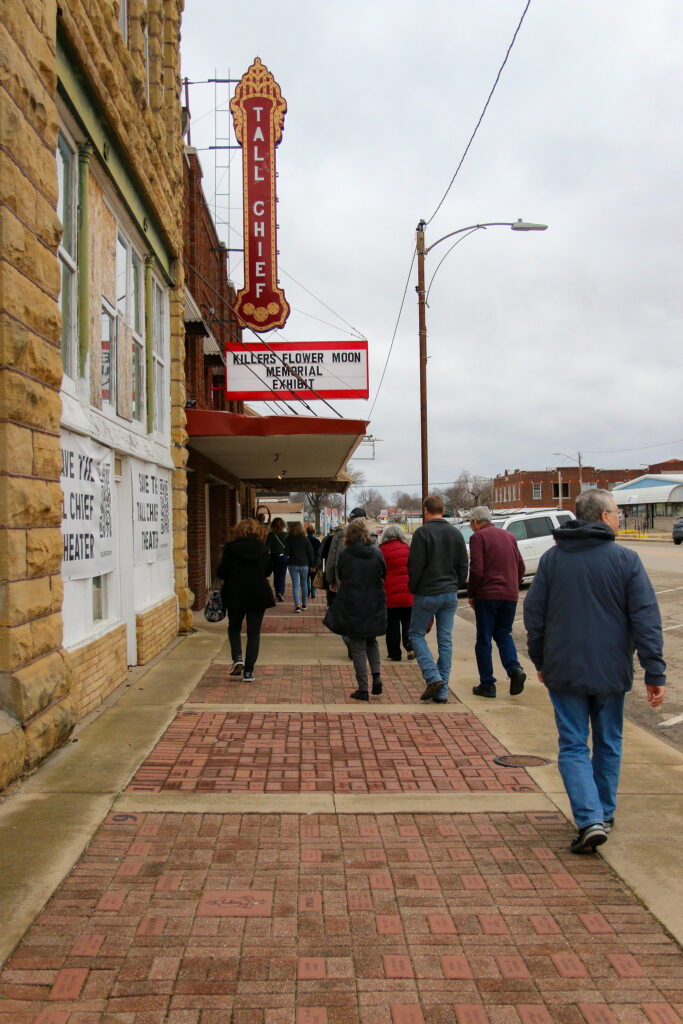
Bus tour participants visit the Tall Chief Theatre in downtown Fairfax, Okla., on Feb. 3, 2024.
KOSU executive director Rachel Hubbard and then-Indigenous affairs reporter Allison Herrera wanted to do an event that focused on the bestselling novel by David Grann, “Killers of the Flower Moon.” The book had been made into a film that received international attention after Martin Scorsese signed on to direct and Leonardo DiCaprio and Robert De Niro signed on in leading roles.
For those of you who may not know, the Osage Reign of Terror was a period that began in the 1920s when oil was discovered on the Osage reservation and tribal members received quarterly royalties from the oil sold. We became some of the richest people in the world, and the outside world was trying to get their hands on our money — even if that meant murdering us.
Grann, Scorsese and DiCaprio’s portrayal of this period was sure to be an international hit. Since millions would see this movie, KOSU wanted to tell the Osage story from an Osage perspective using Osage experts and historians.
Telling this story via a bus tour was Allison’s idea. She had done a bike tour before, and Rachel helped. They both had experience planning an event and had a rough idea of how much it would cost. Rachel was applying for an Oklahoma Humanities grant for the collaboration, and the Osage News had obtained funding from Borealis Philanthropy in a Racial Equity in Journalism grant. Together, we knew we could afford it.
Making the partnership and its logistics work
We had a few group meetings over Zoom where we discussed which newsroom would be responsible for what function and what the agenda would be. We also had to decide whether it would be a paid or a free event. This was an important component, and we decided to charge since the event cost more than $10,000.
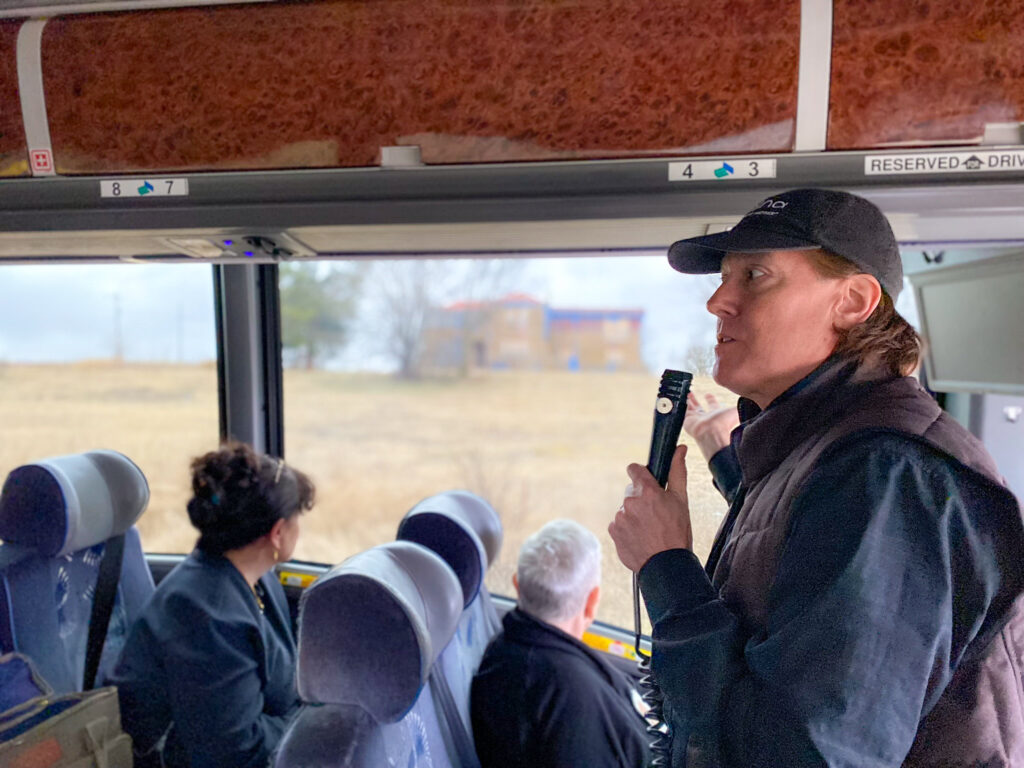
Russ Tallchief tells the history of the Tallchief Mansion and how Maria and Marjorie grew up at this home in Fairfax, Okla., on Feb. 3, 2024.
KOSU was responsible for the buses, the radio segment of the coverage and the scripts for the tour, while the Osage News arranged for the venue following the tour, organized a panel of Osage speakers and hired cooks to present a traditional Osage meal to participants. Together, we chose who those speakers would be and who we would ask to help guide the participants on the tour and tell the history of the areas discussed in the book and film.
We also brought on the Osage News’ sustainability consultant, Verified News Network, and they made the tour posters, managed the Eventbrite for the tickets, kept track of the money, did event check-in and were in charge of the post-event survey and data collection of the responses.
We decided to test the waters and offer 100 spots on the tour. It sold out in less than two weeks and we had a waiting list.
We were able to subsidize the ticket costs at $25 with the funding we had received. But the event was so popular and offered such a quality experience that we could have charged $50 to $100 a ticket, and I think people would have paid for it.
Here’s what our cost breakdown looked like:
- $200 – Venue
- $3,000 – Osage Meal
- $10,000 – Charter buses, honorariums for ten speakers
- $200 – Osage Nation Tax Commission
Initially, we agreed to split the proceeds, which came out to $2,500, but in the end, KOSU donated the full amount to the Osage News, and we used that funding to pay for the meal. The willingness of people to pay for the experience showed us that there was a lot of interest from the community in attending events sponsored by news organizations. It also signaled a new revenue stream for us.
Planning for future collaborations

KOSU and Osage News hosted a ‘Killers of the Flower Moon’ Bus Tour on Feb. 3, 2024. The day concluded with a traditional Osage meal.
Putting on an event of this magnitude took time, and as journalists, we often don’t have much time. That was the biggest hurdle we faced. We mainly met during workdays over Zoom, but a consistent and healthy email/text exchange was also happening. It all crescendoed that last week before the tour, but we never panicked. We had done enough planning so that everyone felt comfortable in their roles, and we had a detailed script of times, locations, etc.
Since Rachel and Allison had planned a tour before, their expertise in the logistics of having two buses was extremely helpful. It also helped to partner with another news organization that had the experience, reach and bandwidth to pull off this type of event. Partnering with an established organization will not only educate you on pulling off your event, but you can always turn to them later for additional questions and assistance.
I would be remiss if I didn’t acknowledge the significant assistance we had from VNN, the Osage News’ consultant team. We could have gotten everything done without it, but the process would have been a lot more stressful. If your organization doesn’t have substantial funding, it will take a lot of volunteers to pull off one of this size. It’s best to start small and grow your events over time.
Following the bus tour, I had several community members approach me and want to volunteer for future events — and they have. I kept a list of every eligible volunteer in our community who might be able to help us in the future. It currently has about 20 people on it. I also keep a list of vendors and venues used, as well as records of who attended for future promotions.
Embracing the opportunities events offer
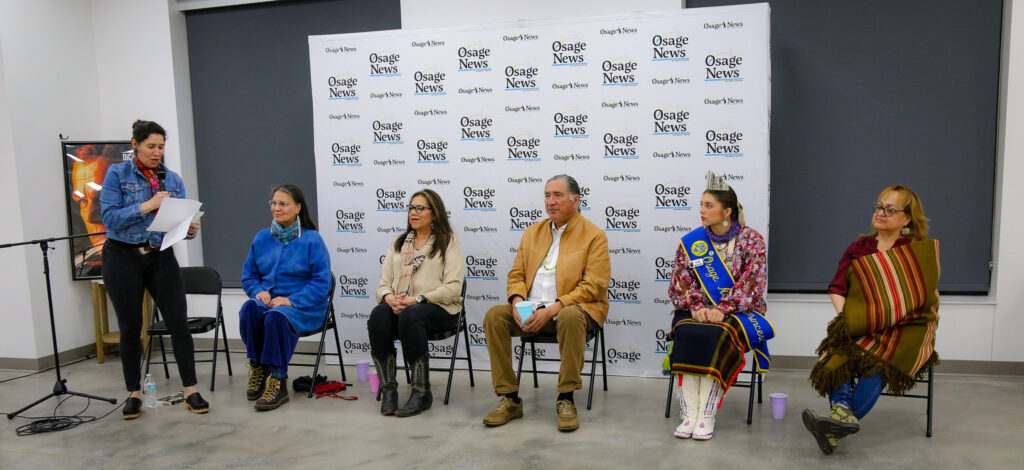
The day concluded with a traditional Osage meal and a panel from Osages who were part of the making of “Killers of the Flower Moon.” From left, moderator Allison Herrera, Dr. Moira RedCorn, Margaret Sisk, Talee Redcorn, Osage Nation Princess Lulu Goodfox, and Dana Daylight.
Reflecting on the past year, the success of our events, and what has been done for our readers and community, I honestly don’t know why we haven’t been doing this all along. Our events provided a safe space for our readers to congregate and talk over news tips and questions they had. Also, in the rural area where we live, we provided a fun, quality outing that our readers enjoyed attending. Many attendees told us they were looking forward to the next one — and since the bus tour, we have hosted six community events with various organizations and our next is scheduled for early 2025. It also drew the attention of possible funders.
By immersing yourself and interacting with your community, you put a face to your reporting and to your news organization. It increases and widens the reach of your brand. They trust you because they know you. And perhaps, even more helpful: They like you. We have since used our events as an opportunity to sell Osage News merchandise, which has since become a revenue stream.
Interacting with your community and providing quality programming while providing the news may seem daunting, but it’s worth it. I got into this profession because I wanted to perform a civic duty. Seeing the smiles on people’s faces or listening to their concerns or observations of something they’ve learned or been enriched with through one of our events is extremely rewarding.
Like I said in the beginning, we’re not just a news organization. We’re a community partner.
Shannon Shaw Duty, Osage from the Grayhorse District, is the editor of the award-winning Osage News, the official independent media of the Osage Nation. Her work has been published in ICT, The Washington Post, the Center for Public Integrity, NPR, Associated Press, The Santa Fe New Mexican, the Tulsa World and more.
Share with your network
4 ways outlets are convening community — and seeing loyalty and revenue follow
You also might be interested in:
As research continues to inform this slice of the news industry, we’ll continue learning, too. Who gets to be called a journalist in 2025 and beyond? What is the future of trustworthy information, especially considering the access to and trust for online content creators? How might journalism adapt to the rise, or co-opt the styles, of news influencers?
What if we started looking at our output as a product, not a service? Too often, we think "product" means a fancy app or a new website. But product isn’t about tech. It’s about intention.
When we began asking what kind of stories still mattered to Baca County, we realized many of them weren’t “breaking news” but generational memory. And the paper was the last remaining platform that treated those memories with care and context.



